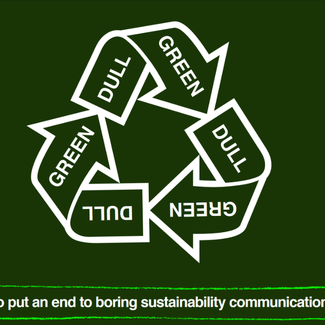
Revolt
Revolt
sustainability
Paying the price for emotionless sustainability creative
As the world continues to be lobbied to act on global warming, Revolt's head of strategy explains why the agency is pushing for more interesting ads to help tackle the issue
25 April 2024
Global warming is no longer a future concern, it is already upon us. Unsurprisingly, this hasn’t gone unnoticed. Climate anxiety is on the rise - a recent 10,000-person study found that 59% of respondents are either very or extremely worried about climate change.
Cue a huge upsurge in the amount of sustainability communications over the past 10 years.
But these are almost always dull. Influential authors Adam Morgan and Peter Field have identified the financial cost of dull communications for businesses. But when it comes to sustainability, failures go beyond the fiscal –- we all pay the price for work that is unable to move hearts and minds.
So, Revolt analysed the emotional strength of sustainability campaigns from the past 10 years to see what good sustainability creative does and doesn’t look like. Each campaign was plotted against eight core emotions. Whilst there are some powerful sustainability campaigns out there, the majority stick to a neutral middle ground – the emotionless.
There are several reasons why companies may be failing to stir minds. There’s the potential for greenwashing, and the harsh penalties that can be imposed. Then there’s ‘greenhushing’ – more companies are withdrawing from sustainability comms for fear of backlash. And, there’s the tendency to over-explain as the information is often complex and scientific.
From our analysis we have identified nine ways that brands can avoid being dull and drive more impact through emotion:
Drive Deeper Feelings
Steal from anything …not just from your category…from anywhere. Canned water brand Liquid
Death took inspiration from the best of the heavy metal for Death To Plastic to drive impact.
Talk about anything, but…let sustainability play a supportive role and talk about what people really want. Tesla markets (sustainable) cars that people really want to own, calling their acceleration mode (made possible through being electric) insane mode.
Don’t talk at all, act…show what you’re actually doing to drive sustainability. Budweiser helped bars selling its 100% renewable beer transition to renewable energy, and then told this story.
Create Gut Feelings
Face the fear…and instil fight over flight with a clear solution. Every 25 minutes, an Olympic-sized pool of oil is used to make synthetic clothing – Woolmark used this in its bold work.
Give lightness to the dark…humour raises awareness. Mars ‘re-used’ favourite ads for the likes of M&M’s and Snickers to tell people about its climate change action.
Get visceral… and use potent and unexpected ways to capture and retain attention. Charity Surfers Against Sewage created ‘The Floater’ – a surfboard made from raw sewage!
Secure Unshakeable Feelings
Drive impact with imagery…Tuvalu’s foreign minister was photographed giving a UN speech
standing knee-deep in seawater to highlight rising sea levels. The photo went global.
Cause trouble… that everyone can get on board with. Channel 4 knew that it would get complaints with its Carbon Skid Marks ad, but also knew it would get people talking.
Bring it home…make sustainability relevant to people’s lives. Renault tackled EV range anxiety by connecting French drivers to homeowners in France with private charging points.
Climate change is threatening our very existence, so we have to up our creative game wit sustainability communication that drives more impact. While the problems we need to solve are usually complicated, and often divide opinion, the communication must be more simple, rousing and unifying.
